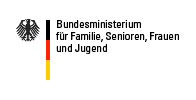Data quality
Quality of data for specialist work oriented to specific target groups and to gender equality
Personal data that are not differentiated according to gender do not form a suitable basis for specialist work oriented to specific target groups and to gender equality. The scope and degree of differentiation of data must be such that they are capable of describing the lives of women and of men in detail in their diversity and in all life situations. It is only in this way that it is possible to recognize findings on discrimination, unequal involvement and possibilities for participation by women and men, for instance as part of a gender impact assessment.
When data collected in a differentiated way taking account of gender are being evaluated, women are frequently presented as a more or less sizeable (percentage or numerical) deviation from a “male” norm. Since women thus appear as a “special case”, such presentations are not very capable of forming the basis for delivering statements oriented to gender equality. They are very possible based on gender bias that impairs knowledge and perception and has a disadvantageous impact in the social utilization of research findings.
Data differentiated in terms of gender form the basis for specialist work oriented to specific target groups and to gender equality. The possibility of making comparisons between women and men is elementary to effective measures for equal treatment of the sexes, as is shown by the way income tax is levied in Austria in a way that is differentiated in terms of gender. In view of the great income gap between men and women , the Income Tax Act, worded in a gender neutral way, has a different impact on women and men (BMF (1999). In view of the great differences in average gross income the question was asked as to whether these differences would be reinforced or reduced by the tax system and to what extent the use of a reduction in tax rates as part of a tax reform would be distributed over men and women. The study’s findings included that reducing tax rates would only have the effect of increasing the income gap between women and men if it were to be restricted to the lower tax brackets and were to be accompanied at the same time by an increase in allowances.
But this kind of collection and evaluation only differentiates according to the biological attribution of gender, which is why the terms sex counting and sex-disaggregated data are used. Forming average values for “men” and “women” makes individuals seem to belong to homogeneous groups. In order to be able to perceive the social gender, including the difference between different women or different men, other differentiation criteria – objectively broken down – must also be included in analysis and interpretation of data differentiated in terms of gender.
In order to depict women and men in various life situations, the relevant features include age, education, origin, income, place of residence (city/country), employment, household and family structure (including children), ethnic background, ability and disability and sexual orientation. Such gender data are crucial for specialist work oriented to specific target groups and to gender equality, as is shown by the following example: A statistical survey of users of cancer screenings and health promotion measures in North Rhine-Westphalia has shown that men use these services significantly less on average that women (Richter/Brand/Rössler 2002). Further differentiation shows that there were great differences here among women from different social classes. Women from lower social classes used health promotion measures significantly less frequently than other women.
To make the relevance of gender for concrete specialist work clear, it is crucial for the quality of data that they are collected and evaluated using indicators oriented to gender equality in order to expose possible discrimination. If, for example, age-specific rates of employment are to be shown using statistics on employment patterns of women and men, the selection of the intervals between the individual age groups is relevant for the gender equality issue. It is important here to take phases of life into account in which the life situations of women and men are significantly different. As mothers still spend more time with their children than fathers do, the compatibility of job and family has a quite different relevance, for example, for women and for men, especially in the age range 20 – 49. (Eurostat 2005). In another subject area such as health, the selection of indicators relevant to gender equality must be adapted to the specific situation of gender relations in the respective subject area.
Further reading:
Richter, M. / Brand, H. / Rössler, G.: Sozioökonomische Unterschiede in der Inanspruchnahme von Früherkennungsuntersuchungen und Maßnahmen der Gesundheitsförderung in NRW, in: Gesundheitswesen 2002; 64, S. 417 – 42.
Eurostat: Gender gaps in the reconciliation between work and family life, Statistics in focus - Population and social conditions, 4/2005.





